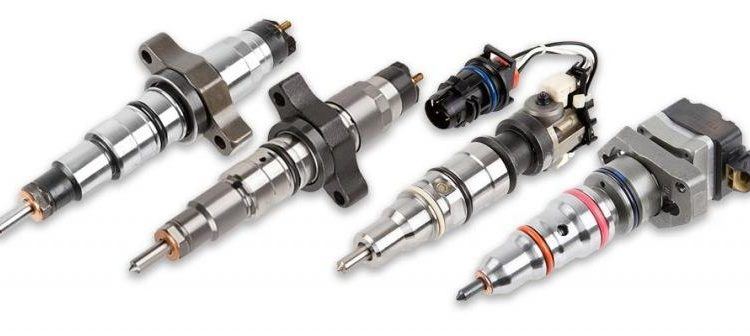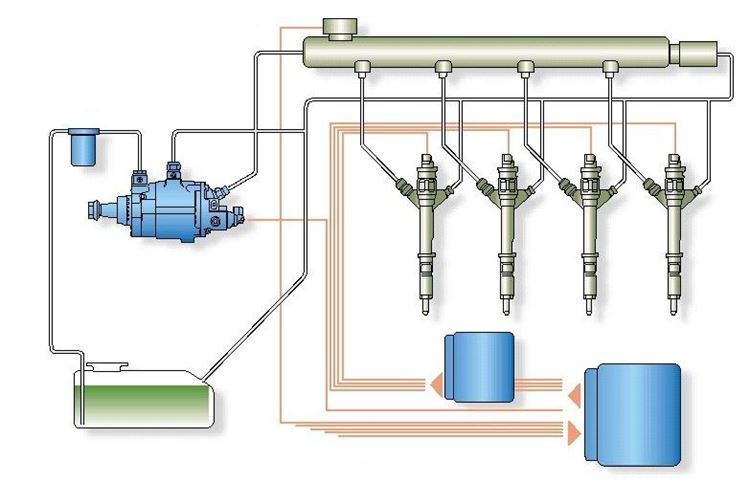Diesel injector diagnostics: possible malfunctions, repairs, reviews
These devices inject fuel in a certain dose into the combustion chamber, where the air is heated to high temperatures and high pressure is created. The nozzles are subjected to the highest loads – the mechanism constantly works in aggressive environments, and the work itself is associated with high intensity. Therefore, injectors often fail. Diagnostics of diesel injectors is the first thing you need to start repairing fuel equipment, and only then move on to other items.
The principle of operation of diesel injection
For a better understanding of the mechanism of the injector, it is necessary to describe the injection cycle in a diesel engine.
So the injection pump takes a certain amount of diesel fuel from the fuel tank. The pump then pumps the fuel into the rail. Diesel fuel is supplied to the channels leading to the injectors. The fuel is then fed to the atomizers. When the pressure level in the atomizer reaches a certain level set by the manufacturer, the nozzle opens and diesel fuel is supplied to the cylinders.
How does a diesel injector work?
On the example of a primitive nozzle, you can consider the principle of operation. On the side there is a channel through which diesel fuel is continuously supplied. Inside the nozzle there is a chamber, it has a barrier. It can move because of the spring. There is also a needle on the device. The barrier can move up or down as the pressure rises or falls. The needle can rise under pressure, thus clearing the way for fuel. This is how a primitive nozzle with a spring works.
Common-Rail
In power units with this power system, two types of nozzles are installed: these are electromagnetic and piezoelectric. The latter is a very serious mechanism, it is compared with Ferrari cars, and the analogy is not accidental, given the frequency of work. To facilitate the diagnosis of diesel injectors in the event of a malfunction, it is necessary to understand their structure and principle of operation.
The electromagnetic nozzle is a body with a solenoid inside, a multiplier valve, a plunger acting on a needle in the atomizer body. All this is complemented by channels for supplying and discharging fuel.
Everything works as follows. Diesel fuel is supplied through high pressure channels from the rail to the needle, where it contacts the nozzle, and into the cavity above the plunger. Due to this, the piston presses the needle to its seat. At the right moment, the solenoid will rise and open the valve – the cavity above the plunger will connect to the drain channel. Since the pressure on the plunger decreases and around the needle increases, the needle rises due to pressure and fuel is injected. As soon as the solenoid returns to its place, the pressure on the piston returns to normal, and the needle instantly closes.
The piezoelectric nozzle works in the same way, but here is a different device. The design of the mechanism has an additional hydraulic compensator – it is an intermediary between the piezoelectric element and the multivalve. In general, the details are almost the same as in the electromagnetic nozzle.
The beauty is that when electricity is applied to the piezo element, it changes its characteristics and geometry in just 0.1 ms. This speed of operation allows the injection cycle to be divided into several processes, maintaining such an accurate dosage that not a single gram of diesel fuel will be wasted.
For better understanding
The fuel injection cycle is divided into three parts: they are pre-injection, main phase and final phase. So, during the preliminary part, only a small part of the fuel is supplied to the cylinders, something within 2 ml. This is necessary in order to heat and prepare the air in the combustion chamber when the main part of the fuel is supplied. This equalizes the pressure inside the cylinder. The main phase is clear and nothing more needs to be described. But the injection of a small portion is needed in the final phase, so that the mixture remaining in the cylinder burns out. This contributes to better cleaning and regeneration of particulate filters.
The advantage of piezoelectric injectors is that they can supply fuel several times in one cycle. Thanks to this, the engine works very well and it is almost impossible to distinguish it from its gasoline counterparts.
What usually breaks down in electromagnetic nozzles
It’s worth starting with electromagnetic mechanisms. The main and worst enemy of any injector is bad fuel and water. But of course, in the process of diagnosing diesel injectors, natural wear is also observed.
The most common malfunction is the wear of the gearbox ball joint. If the plunger is not closed tightly, this will cause diesel fuel to flow into the drain line. If insufficient pressure is applied to the plunger, fuel may flow out through the atomizer. If there is no leakage through the irrigation head, but there is through the drain channel, then under load the motor will stall. If the needle is compressed, there is compression of the plunger, if the needle is not tight or not at all, this will lead to overflow. The engine will run in jog mode, while idling, white smoke may come out of the pipe. If you diagnose conventional diesel injectors, then most likely these shortcomings will be identified.
The spring pressing the needle also loses its rigidity. Due to corrosion, the multiplier wedges. There are also issues with the solenoid opening the intake valve; all this does not add stability to a running engine.
Each part of the nozzle is subject to one or another negative impact, and even a minor part can lead to unstable engine operation.
Malfunctions of piezo injectors
As for the malfunction, everything here is about the same as for devices of an outdated design. But at the expense of a more complex control element, you can add a short circuit to the "ground" of the piezoelectric element. This can result in the engine simply not starting.
Breakdowns of needles and atomizers have been mentioned above, but it should be added that if the nozzle overflows heavily, then a lot of black smoke will come out of the exhaust pipe. This is a signal for diagnosing diesel injectors.
Less often, the piezoelectric element fails or loses its properties. In case of loss of properties, the engine may lose traction and triple. It is necessary to mention coking.
How to check nozzles in the service station
Faced with complaints of internal combustion engine smoke, loss of traction and other symptoms described above, the first step is to conduct computer diagnostics. And if the system gives errors during the process, then the elements are dismantled and transferred to the workshop for further diagnostics of diesel injectors on the stand.
The element is installed on a bracket, where the main indicators are checked: is the fuel poisoned through the drain line, is there a leak and at what pressure does it occur. If the diagnostics on the stand shows that everything is in order, then the element is installed on more serious equipment, where the operation of a diesel engine is almost completely simulated. In the course of such diagnostics of the operation of diesel injectors, automation will gradually measure all the parameters and characteristics of the injector, which will make it possible to understand the causes and problems.
The nozzle is then directed to an ultrasonic bath to remove carbon deposits and coke. Then the part is sent to a special stand, where it is dismantled for subsequent repair.
DIY diagnostics
You can independently diagnose common rail diesel injectors. This can be done in two ways: checking the injectors on a ramp and a makeshift stand, checking the engine.
Judging by the reviews, the easiest way to check the operation of the injectors in the engine is without removing it. To do this, the engine must be idling. Then the owner must unscrew the atomizers in turn. If, after removing the atomizer, the operation of the motor has deteriorated, then the nozzle is working. So, by the method of elimination, you can find a non-working nozzle – when you unscrew the sprayer, the operation of the engine will not change.
You can also check the tightness of the injectors directly on the engine. To do this, you will need special plastic containers and connecting hoses. The hoses are connected to the nozzles. Containers should hang vertically.
Then start the engine and start watching. If one of the prepared transparent containers fills up faster than the others, this is a problem. When testing nozzles, make sure containers are no more than three-quarters full. The norm for such tests is a difference of 10%. If the difference in fuel volume is greater, then you need to check for leaks.
This diagnostic method is simple and effective, but the problem is not always related to leaks.
Conclusion
This is how diesel injectors are diagnosed. Repair involves ultrasonic cleaning, as well as the replacement of worn parts. Check each washer, solenoid travel, snap rings, measure all bushings. Everything worn out is replaced with new.






